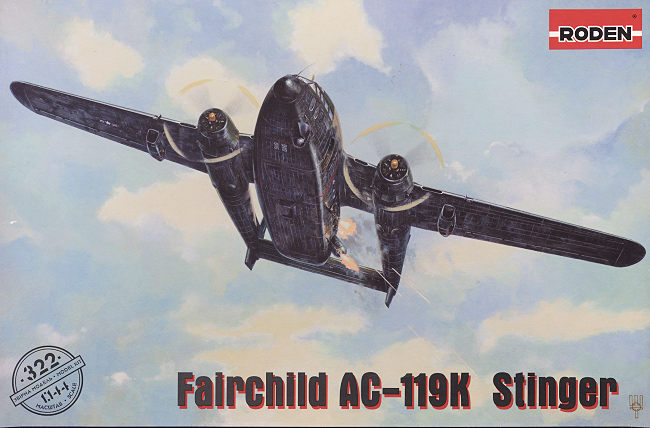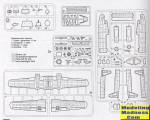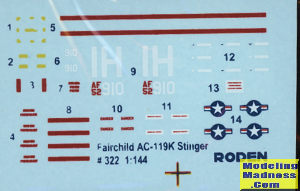
Roden 1/144 AC-119K 'Stinger'
| KIT #: | 322 |
| PRICE: | $16.98 |
| DECALS: | One option |
| REVIEWER: | Scott Van Aken |
| NOTES: |

| HISTORY |
By late 1967, the idea of the fixed-wing gunship had been proven so successful, the United States Air Force was having a difficult time keeping up with demand. The newer AC-130s that had been created under Project Gunship II were effective, but were being mostly used for armed reconnaissance and interdiction of the Ho Chi Minh Trail. Furthermore, the C-130 airframe was in active service as a transport, vital to the war effort in Southeast Asia. The Air Force desperately needed a new gunship to replace the vulnerable and underpowered AC-47 in the close air support role, as well as supplementing the AC-130 in attacking targets on the Ho Chi Minh Trail.
The Fairchild C-119 Flying Boxcar presented an obvious choice, having been phased out of front-line service in favor of the C-123 and C-130, and with the stock of available airframes in U.S. Air Force Reserve being sufficient. In February 1968, under the USAF program Project Gunship III, 26 C-119Gs were converted to AC-119G standard, initially taking on the name "Creep", but later assigned the callsign "Shadow". These aircraft were primarily intended to replace the AC-47 in the close air support role.
In addition, Fairchild-Hiller, which was contracted for all the conversions, converted another 26 C-119Gs into AC-119Ks, primarily for the "truck hunter" role over the Ho Chi Minh Trail. These aircraft were called "Stingers" primarily in reference to the two M61 Vulcan 20-mm cannons they carried in addition to the AC-119G's four GAU-2/A miniguns. The AC-119K could be visually distinguished by the addition of two General Electric J85 turbojet engines in underwing pods. The conversions were completed at Fairchild-Hiller's facility in St. Augustine, Florida.
Project Gunship III, being a follow-on to the success of the AC-130 series, meant that the AC-119 was a more advanced aircraft in both its iterations than the AC-47. Even the TIC AC-119G featured some of the most up-to-date electronic countermeasures and radar equipment, as well as more basic technology, including an AVQ-8 xenon light, a night observation sight, and an LAU-74/A flare launcher.
The AC-119K, designed to hit trucks on the Ho Chi Minh Trail, was more advanced. Included in the conversion was the AN/APN-147 Doppler navigation radar, AN/AAD-4 forward looking infrared, AN/APQ-133 side-looking beacon tracking radar and AN/APQ-136 search radar.
The armament scheme for both aircraft was simpler than that of the AC-130. The AC-119G had a total of four GAU-2A/A miniguns in SUU-11A/A pods, all on mounts similar to those used on early AC-47s. Like late-model AC-47s, these were soon changed to the purpose-built MXU-470/A minigun modules. The AC-119K, needing a more powerful and longer range "punch" to take out vehicles, featured two M61 20-mm cannons in addition to the four miniguns of the AC-119G.
| THE KIT |
 This
was another purchase based on a decal sheet. In this case it was AOA's nice
1/144 sheet on the AC-119. The kit is standard Roden with ejector pin marks or
towers on the inside of the larger pieces and some of the smaller ones (such as
the doors). Means a bit of work with clean up. I also found a little flash, most
notably on the engine cowlings. The window transparencies are a bit thick, but
have well defined frames. There is no cockpit or cabin interior so you may want
to paint those areas black.
This
was another purchase based on a decal sheet. In this case it was AOA's nice
1/144 sheet on the AC-119. The kit is standard Roden with ejector pin marks or
towers on the inside of the larger pieces and some of the smaller ones (such as
the doors). Means a bit of work with clean up. I also found a little flash, most
notably on the engine cowlings. The window transparencies are a bit thick, but
have well defined frames. There is no cockpit or cabin interior so you may want
to paint those areas black.
The AC-119 bits are on a separate sprue that contains the gun shapes and some sensor housings. You can build this as the G if you follow the AOA instructions. The holes for the auxiliary jet engines will need to be opened if doing the K. You are also provided two additional noses, one being the stock nose appropriate for the G. Note that all the small cabin windows insert from the inside so you will have a bit of masking to do.
Engines are a half cylinder section that fits into the nacelle. Oddly, the four-bladed prop is assembled from two two-blade sections with one half having the hub. Wings are a single upper surface with two lower halves. You glue the lower nacelles to this along with the engine cowling to provide a mating surface for the tail booms. These booms have separate strakes on the underside. This is undoubtedly to allow the earlier C-119 to be kitted. 6 grams of nose weight is required and there is lots of room for it. The landing gear is properly long for the main gear and it looks to be strong enough to hold everything up. I'd recommend not installing the gear or any of the antennas until after you have painted the kit.
 There is but a
single markings option in the modified SEA camouflage scheme. Modified as the
underside and tails are black. Roden provides a full color painting diagram
which should be a real help. The lone option is for a training squadron in the
US, the 4413th CCTS in Florida. Decals look well done, but my experience
with Roden decals is not entirely positive so I rarely buy a Roden kit without
having aftermarket decals available. Note that the bars in the insignia are
pretty far of register, but not to worry as a small addendum sheet has been
included to take care of that.
There is but a
single markings option in the modified SEA camouflage scheme. Modified as the
underside and tails are black. Roden provides a full color painting diagram
which should be a real help. The lone option is for a training squadron in the
US, the 4413th CCTS in Florida. Decals look well done, but my experience
with Roden decals is not entirely positive so I rarely buy a Roden kit without
having aftermarket decals available. Note that the bars in the insignia are
pretty far of register, but not to worry as a small addendum sheet has been
included to take care of that.
| CONCLUSIONS |
This kit makes a viable option to the much larger and much more pricey Italeri kit. Its overall smaller size won't make such a major impact on your display shelves and it should make into a very nice model with a little bit of care during construction. Heck, considering the parts in the kit, you could easily do a standard transport if you have the markings for it.
| REFERENCES |
https://en.wikipedia.org/wiki/Fairchild_AC-119
April 2018 Copyright ModelingMadness.com. All rights reserved. If you would like your product reviewed fairly and fairly quickly, please contact the editor or see other details in the
Note to
Contributors. Back to the Main Page
Back to the Review
Index Page
Back to the Previews Index Page